In the realm of music, one category stands out for its raw energy, powerful riffs and aggressive tone – Heavy Metal.
This genre, cherished by millions worldwide, owes much of its distinct sound to characteristic chord progressions.
The art of strategically arranging these chords can transform a simple tune into an electrifying spectacle.
By gaining a deeper understanding of these progressions, musicians unlock the potential to create pieces that resonate profoundly with their audience.
This article seeks to dissect the anatomy of metal chord progressions, exploring techniques designed to captivate listeners and leave a long-lasting impression.
Let’s delve into the science and strategy behind Heavy Metal’s distinctive musical architecture without further delay.
Table of Contents
- Metal Chord Progressions
- I-IV-vi-VII (1-4-6-7)
- i-iii-IV-vi-VII (1-3-4-6-7)
- ii-iii-vi-VII (2-3-6-7)
- I-vi-iii-IV (1-6-3-4)
- ii – IV – V – ♭VII (2-4-5-♭7)
- I-III-IV-vi (1-3-4-6)
- I-vi-IV-VII (1-6-4-7)
- II-VI-VII-i (2-6-7-1)
- i-III-VI-VII (1-3-6-7)
- i-iv-VII-i (1-4-7-1)
- iii-IV-VII-I-II (3-4-7-1-2)
- i-iv-VI-i (1-4-6-1)
- I-iii-IV-vi (1-3-4-6)
- i-II-iv-VI (1-2-4-6)
- iii-vi-VII-II-vi (3-6-7-2-6)
- i-VI-III-VII (1-6-3-7)
- ii-vi-ii-III-vi (2-6-2-3-6)
- The Bottom Line
Metal Chord Progressions
I-IV-vi-VII (1-4-6-7)
Unlocking the power of tension, this progression fuels epic metal anthems.
This chord progression of I-IV-vi-VII creates a uniquely powerful and raw sound that is essential to many metal genres. The seemingly simple progression can create profound suspense and resolution, often creating an impactful and intense musical experience.
- Difficulty: Intermediate
- Example: C – F – Am – B (Key of C Major)
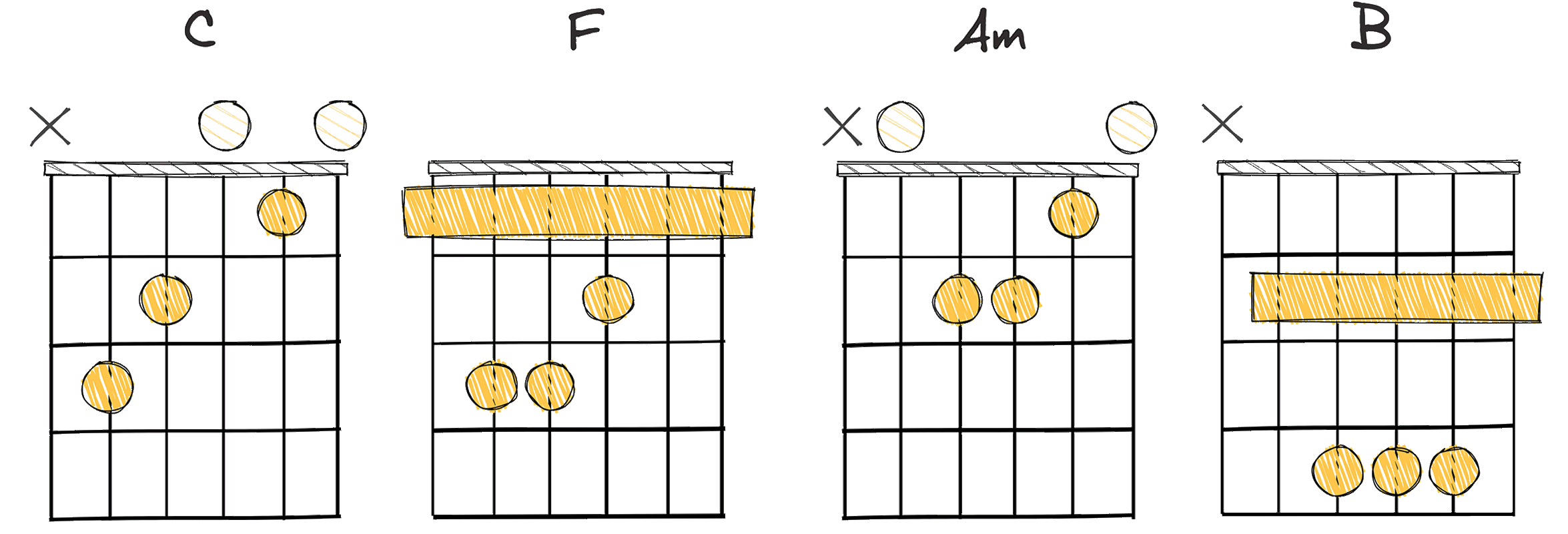
The I-IV-vi-VII chord progression, numerically representing 1-4-6-7, is an interesting concept in musical composition, especially when broadly applied within the genre of heavy metal.
This unique chord progression creates an aura of passion, aggression, and raw energy that’s central to metal music.
History shows a versatile pattern of use, with the very first instances of I-IV-vi-VII appearing in classical music, only to evolve through different music periods till today.
The evolution of this sequence throughout time and its adoption by various music genres have subtly shaped its present understanding and application in the modern metal music context.
In the arena of heavy metal music, the I-IV-vi-VII progression, while appearing somewhat infrequent compared to others, adds an exotic and mysterious undertone when it does feature.
It’s this exotic air that invites both the musicians and listeners to further explore and appreciate the depth it brings to otherwise intense metal tracks.
Acknowledging the excitement around the unique sound it creates, metal musicians have utilized it in various sub-genres to add an unexpected twist.
With the chord progression being intermediate to play, it provides a great ground for many guitarists and songwriters in metal music to experiment with their creativity.
There’s always been a sense of intrigue and deviation demanded by metal music, which makes the I-IV-vi-VII progression an apt choice.
Whether it’s down-tuning portions of the progression or incorporating shrill screeches from extended techniques, the musical landscape of this progression remains a playground for experimentation.
The I-IV-vi-VII progression‘s ability to color songs with varied dynamics while also offering room for personalizing implies its continuing relevance in the fast-evolving genre of metal music.
As we delve deeper into discussing the other progressions in forthcoming sections, we’d do well to appreciate the foundational role that I-IV-vi-VII has carved within the sonic tapestry of iconic metal pieces.
i-iii-IV-vi-VII (1-3-4-6-7)
This progression unleashes pure metal mayhem with its unexpected turns.
This progression, known as i-iii-IV-vi-VII, is a staple in metal music known for its powerful and dramatic flair. It provides a mix of dark and melodic tones which can create intensely atmospheric tracks, often resulting in memorable, hard-hitting riffs.
- Difficulty: Intermediate
- Example: Gm – Bm – C – Em – F# (Key of G minor)

When discussing progressive metal, it’s impossible not to delve into the unique approach of chord progressions that are extensively used in this music genre.
The chord progression of i-iii-IV-vi-VII (1-3-4-6-7) has carved a significant niche in the realm of metal music.
It’s an interesting balance of contemporary harmony and traditional metal that gives this progression its uniquely metal flare.
This chord progression is typically construed as Intermediate due to its characteristic use of non-diatonic chords.
But this complexity isn’t a barrier; instead, it brings out an intricate melodic evolution that appeals to the ears of discerning metal enthusiasts.
The first chord of the progression, i (in the Key of G, G minor) starts the progression with a dark and gloomy tone, creating the perfect atmosphere that metal often evokes.
The transition to the third chord (III, B minor in the Key of G), adds a brighter and more uplifting vibe, creating a stark contrast with the preceding minor chord.
This unexpected shift in mood is what gives metal its dramatic edge leaving the listener in anticipation for what’s to come.
The dissonant tension created between the III and IV chords is often resolved by moving onto the VI, and finally to the VII.
This circular movement keeps the listener engaged and forms the backbone of many famous metal riffs.
The i-iii-IV-vi-VII chord progression’s circular disposition evokes an array of emotions, and with the right technique, it can truly melt faces and blow minds.
All in all, studying the nature of these progressions and incorporating them into your music can add a new level of depth and dynamics to your metal compositions.
So, if you’re an aspiring metal guitarist or an established musician looking for sophisticated chord progressions to incorporate into your songs, this progression could potentially be your next muse.
With their roots deeply intertwined with the history of progressive metal, they’ve proven time and again their capacity to enthrall listeners and create widely recognized and loved metal classics.
ii-iii-vi-VII (2-3-6-7)
Unleashes powerful tension release in metal’s raw and intense style.
This chord progression invokes a sense of rising tension and anticipation, often used in metal music to create a deeply immersive and intense atmosphere. The transition from II to iii enhances the melodic drama, while the immediate leap to VI and VII establishes a powerful, energetic aura characteristic of heavy metal genre.
- Difficulty: Intermediate
- Example: Em – F#m – Bm – C# (Key of D)
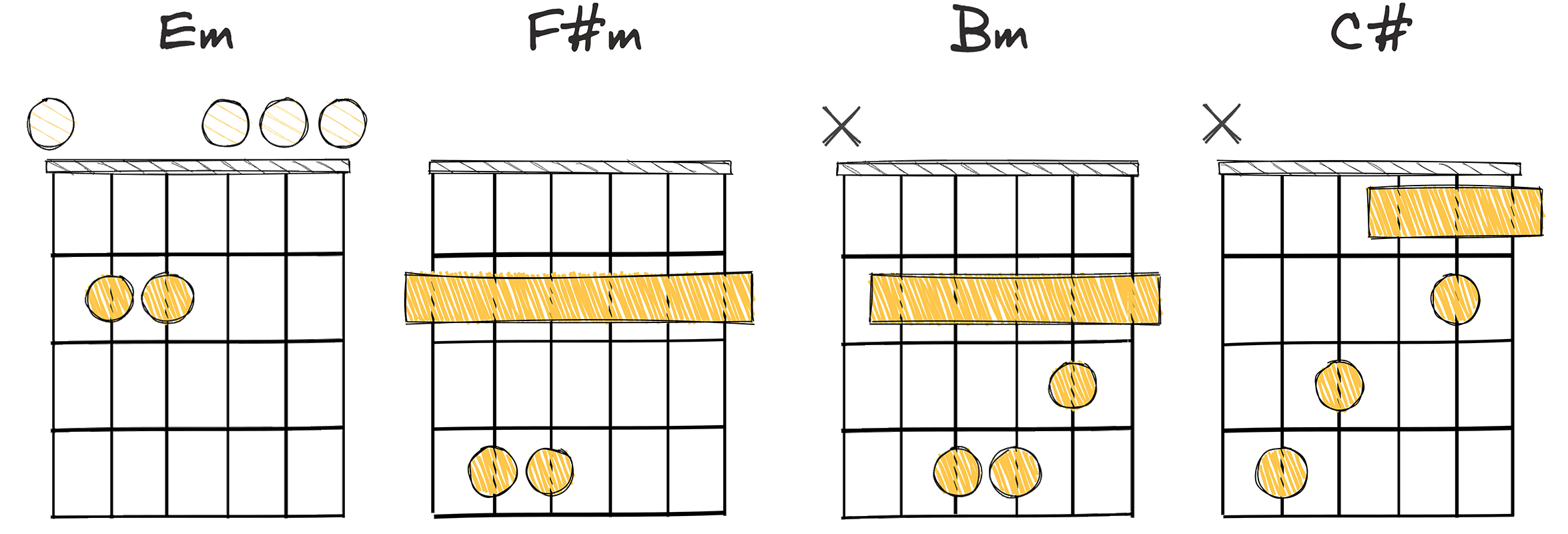
If there’s a chord progression that stands ready to ignite the metal world in sheer auditory combustion, it is the ii-iii-vi-VII (2-3-6-7) progression, which in the key of D, translates to Em – F#m – Bm – C#.
Its use dates back to some of the earliest pioneering metal bands that sought to push the boundaries of traditional musical arrangements.
Unleashing a raw energy that quickly gained traction, this chord progression sparked a movement and a new approach to song composition.
Among the bands using this 2-3-6-7 progression, fans of 90s alt-metal may recognise its forceful resonance in Tool’s revolutionary sound.
The ii-iii-vi-VII progression’s combination of major and minor, as well as diminished chords, provides exquisite tension building and release in the context of heavy metal music.
One key characteristic metal music boasts is the element of tension and release.
This chord progression provides a heavy, intense emotional ride, given the balance of major, minor, and diminished chords.
Talking about this chord progression, it is intermediate in difficulty to play.
Therefore, it’s a great addition to a metal guitarist’s repertoire, but also a good starting point for beginners who want to familiarize themselves with more complex chord progressions.
This progression is perfect for the metal genre due to its tonally rich and intricate pattern.
The ii-iii-vi-VII progression is a potent weapon in a heavy metal guitarist’s arsenal.
It enables wide-ranging creativity and facilitates the creation of memorable riffs and catchy melodies.
Listen to your favorite metal songs.
You might notice a familiar chord progression, this ii-iii-vi-VII structure cropping up with considerable frequency.
The legacy of this chord progression is that it continues to push metal music forward, never falling into cliché or predictability.
This progression represents a deep well of possibilities that continues to inspire artists the world over.
I-vi-iii-IV (1-6-3-4)
Dynamic progression fusing strength and melancholy
The I-vi-iii-IV (1-6-3-4) chord progression is an excellent structure for metal music due to its perfect blend of power and emotion. The major I and IV chords provide a strong and triumphant backbone, a classic trait of metal’s intensity, while the minor vi and iii chords introduce a sense of depth and intrigue. This combination of major and minor chords creates a rollercoaster of sonic tension and release, capturing the soul of metal’s complex narratives.
- Difficulty: Intermediate
- Example: F – Dm – Am – Bb (Key of F major)
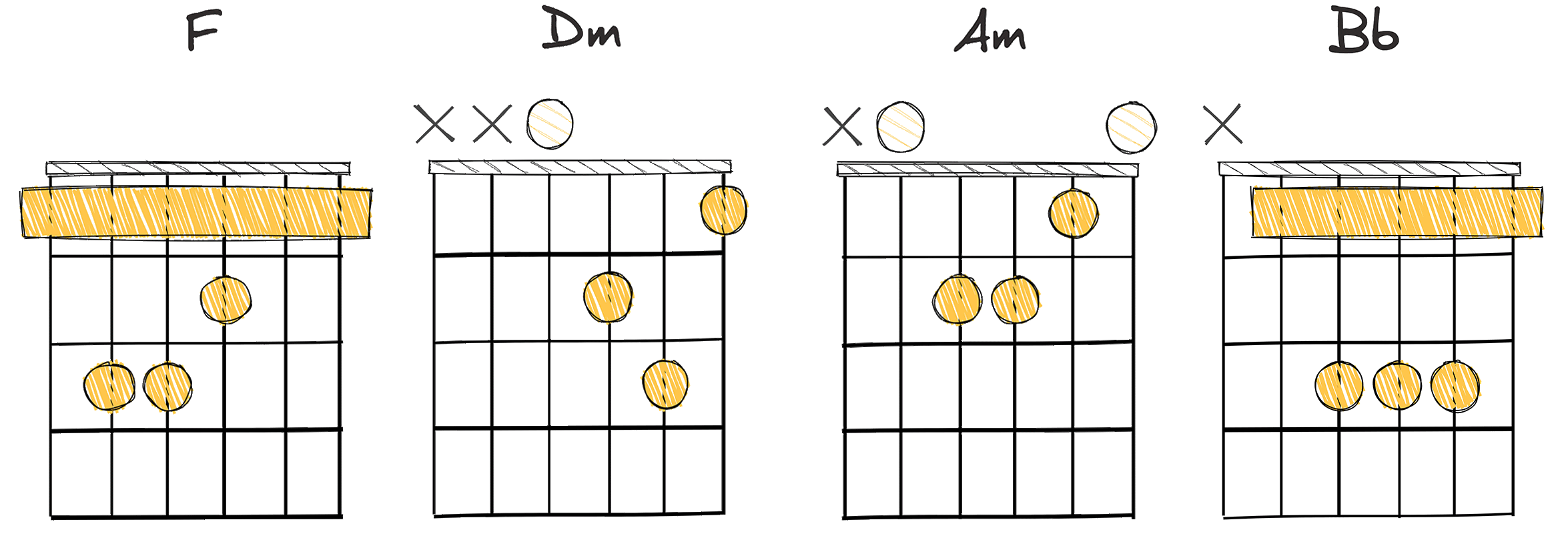
When it comes to energizing your metal music compositions with dramatic intensity, the I-vi-iii-IV chord progression is a tool that can instill a sense of both strength and profound emotion in your sound.
Historically, this progression has found a home in the powerful genre of metal and other genres, underlining its versatile and dynamic nature.
At its core, the I-vi-iii-IV chord progression is sculpted by a journey from the ‘I’ chord (first chord in a major key) to the ‘vi’ chord (sixth chord in a minor key), transitioning to the ‘iii’ chord (third chord in a minor key), and resolving on the ‘IV’ chord (fourth chord in a major key).
This specific sequence resonates with a blend of triumph and mystery, marking its unique space in the musical landscape.
While it may not be as commonly used as other progressions, the I-vi-iii-IV has abundant potential, providing a fertile ground for innovation, experimentation, and emotional depth.
For example, in a key like F major, this progression would be represented by F – Dm – Am – Bb.
Whether in the key of F major or any other major key, an insightful understanding of the chords and their relationships within the context of the scale is essential to unlocking the full power of this progression.
Mastering the I-vi-iii-IV requires a blend of theoretical knowledge and creativity and artistry.
These progressions connect with listeners today due to their innate balance of power and melancholy, crafting a musical narrative that feels both compelling and nuanced.
The I-vi-iii-IV opens a universe of possibilities in music creation, encouraging musicians to experiment, adapt, and reimagine, infusing fresh vigor into a richly textured progression.
The I-vi-iii-IV chord progression is a compelling testament to these four chords’ depth and infinite potential, offering a path to musical adventure that resonates within the soul of metal music and beyond.
ii – IV – V – ♭VII (2-4-5-♭7)
A fiery progression igniting powerhouse riffs in metal music.
The ii – IV – V – ♭VII (2-4-5-♭7) chord progression is an unconventional sequence often used in metal music, known for creating intense and powerful tonal structures. It provides a melodic surprise that defies common expectations, hence its reputation for melting faces and blowing minds.
- Difficulty: Intermediate
- Example: Em – G – A – C (Key of D)
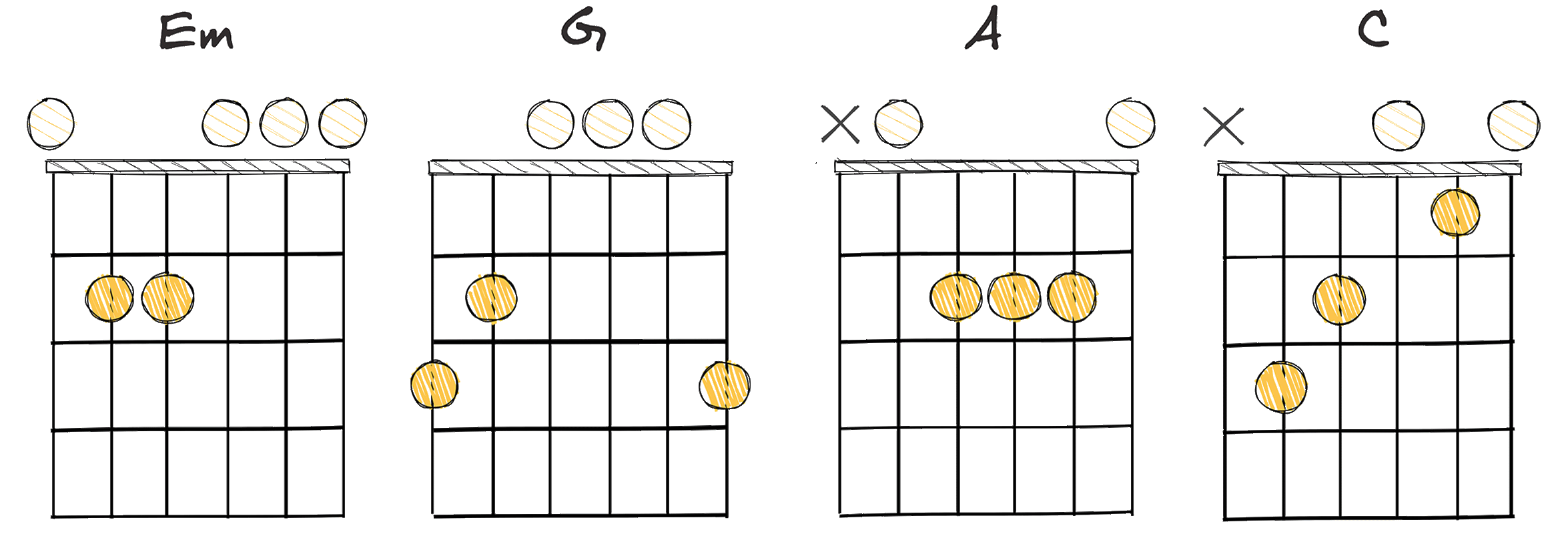
The progression ii – IV – V – ♭VII, or as it corresponds in the key of D, Em – G – A – C, is a striking chord progression often employed in the realms of heavy metal music.
All the chords Em, G, and A are indeed all diatonic to D major.
The C major chord, however, is not.
If you’re basing the progression on the key of D major, the C major chord would be seen as a borrowed chord from D minor (the parallel minor).
There is, in fact, a unique power that these four chords hold when they are played together, which forms the very foundation for a number of legendary metal tracks that have changed the face of music over time.
Interestingly, this progression has its roots deeply embedded in classical music, showcasing the dramatic tension created by the shifting root of each chord.
This element of tension and release, a cornerstone in the legacy of composers like Beethoven, found its way into the fabric of heavy metal music and brought a new depth to its sound.
It is worth noting that the ii – IV – V – ♭VII progression, while potent in its capabilities, requires a certain degree of mastery to be successfully implemented, classifying it as an intermediate-level progression within metal music.
There is still, however, much to be explored in terms of unorthodox chord progressions in the ever-evolving world of metal music.
The rich tapestry of heavy metal is ever-expansive and embracing more inventive and groundbreaking methods such as the ii – IV – V – ♭VII progression, can lead to the discovery of new soundscapes which could potentially revolutionize this genre.
There is a certain diversity that remains yet to be unearthed within the realm of metal music, and the progression ii – IV – V – ♭VII could be an untapped reservoir for artists seeking to push the boundaries.
The exploration of this progression, along with countless other unconventional progressions within metal, will aid musicians in their search for truly distinctive and authentic sounds, thus taking the genre to new heights.
This, in turn, can pave the way for more unique and varied chord progressions to be discovered, marking a fresh chapter in the history of heavy metal music.
I-III-IV-vi (1-3-4-6)
Experience power-packed, emotive melodrama with this commanding metal progression.
This unique chord progression beginning with the first degree, jumps up to the third, before descending to the fourth and sixth. It generates a feeling of intense energy and power, typical of metal music, making it excellent for heavy riffs and shredding solos.
- Difficulty: Intermediate
- Example: C – E – F – Am (Key of C)
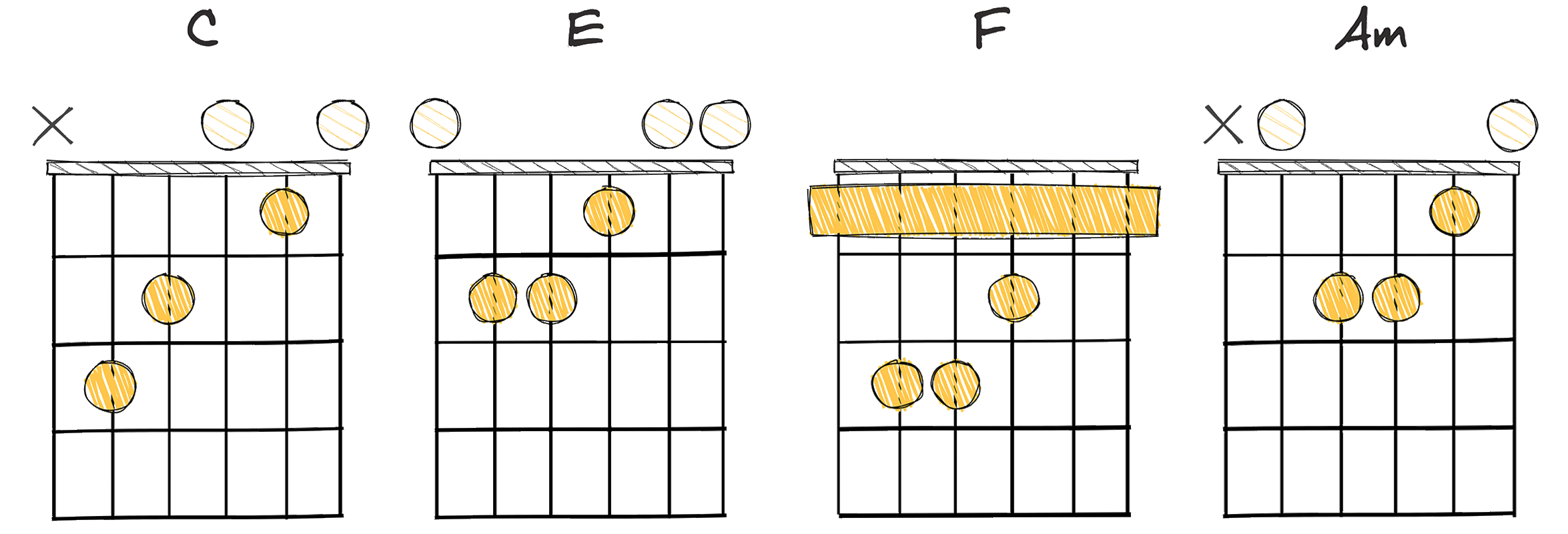
Metal music has a rich history of delivering strong, impactful chord progressions that can stir the soul and captivate the listener.
I-III-IV-vi is one such chord progression that has defined a generation of metal musicians
This progression, translating to C Major – E Major – F Major – A Minor in the Key of C, creates an air of melancholy and intensity, perfect for many sub-genres of metal.
It is considered to be of an intermediate level, striking a balance between being easy to play for beginners and intricate enough for skilled musicians to skillfully explore.
Interestingly, this four-chord progression originated from classical music, but metal bands incorporated it into their songwriting due to its raw emotive power.
Thus, many famous metal songs crafted over the years have utilized this chord progression.
It is a progression that, through its simplicity, allows for a myriad of possibilities in terms of harmony and tension.
Furthermore, its solid rhythmic foundation provides a perfect backdrop for powerful vocal melodies and intricate guitar solos, which added to its popularity among metal bands.
This progression has been used in a multitude of styles within the genre of metal, from power ballads to thrash metal anthems.
It continues to be a popular choice, as each chord’s specific tonal qualities can evoke a different emotional response from the listener.
Through its intricate history and widespread usage, the I-III-IV-vi progression has proved its worth as a foundational building block in the creation of influential metal music.
It is no wonder that from the origins of metal to its modern-day iterations, it remarkably continues to be a popular choice for composers and musicians alike.
I-vi-IV-VII (1-6-4-7)
An electrifying progression for explosive, mind-bending metal riffs.
The i-vi-IV-VII progression presents a powerful sequence often used in metal music to produce a hefty, dramatic effect. It starts on the minor tonic, falls to the relative sixth, ascends to the subdominant, and then soars to the leading tone, offering a mix of harmonic tension and resolution, perfect for aggressive riffs and head-banging rhythms.
- Difficulty: Intermediate
- Example: E – C#m – A – D (Key of E)
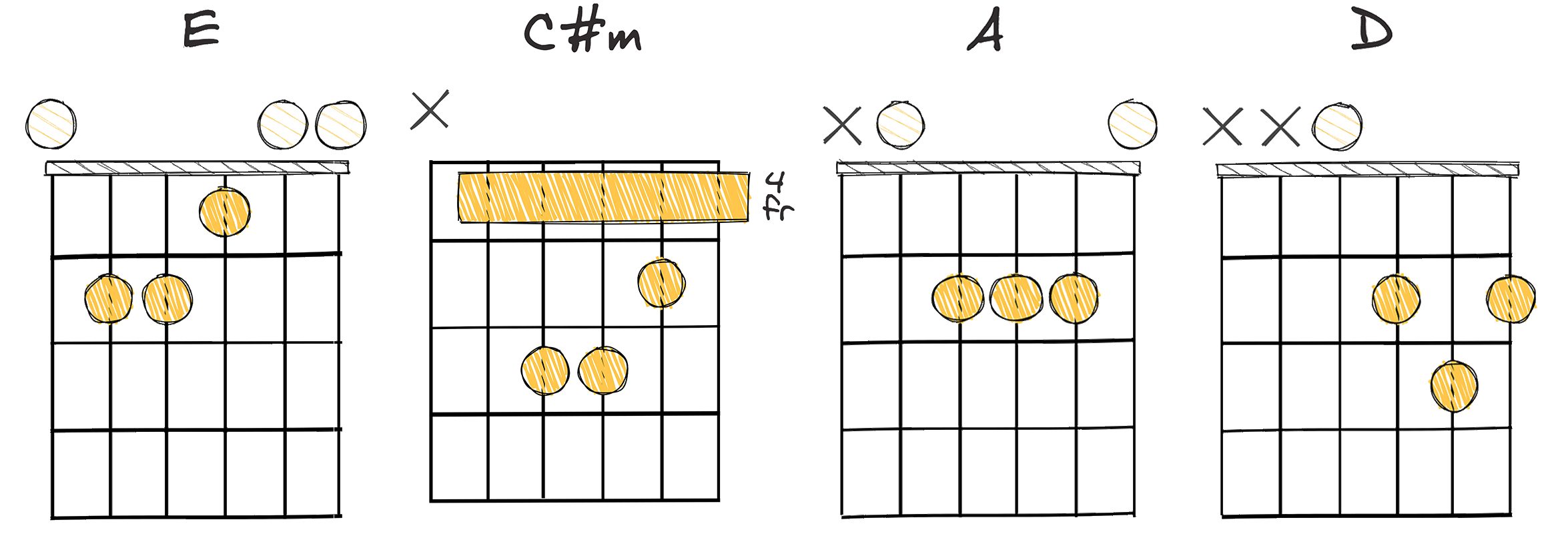
The chord progression I-vi-IV-VII, which corresponds to the notes E – C#m – A – D in the key of E, has been an indispensable part of the metal genre’s arsenal for decades.
Historically, this progression has been used by countless bands to underpin their most hard-hitting tracks, creating a sense of intense drama and head-banging brilliance that fans can’t get enough of.
While this chord progression can be heard across a range of metal sub-genres, it’s most frequently found in the realms of progressive, symphonic, and melodic death metal.
The beauty of this chord progression lies in its balance between simplicity and complexity.
On one hand, the progression is built from standard, easy-to-play chords, allowing beginners to pick it up quickly.
On the other hand, the intervals between the chords offer a wealth of possibilities for creative and intricate riffing.
This makes it a treasure chest of ideas for more advanced players.
In essence, the I-vi-IV-VII progression (E – C#m – A – D) is a perfect mix of accessibility and depth that lets musicians of all skill levels unleash their inner rockstars.
II-VI-VII-i (2-6-7-1)
A dynamic, edgy chord progression to ignite fervor-filled metal solos.
This obscure chord progression offers a distinctive metallic sound, using a minor i chord to bring a dark, emotional depth. The II-VI-VII movement provides a unique edginess often utilized in heavy metal music, creating suspenseful anticipation that leads perfectly into the climactic resolution of the minor i chord.
- Difficulty: Intermediate
- Example: B – F – G – Am (Key of A Minor)
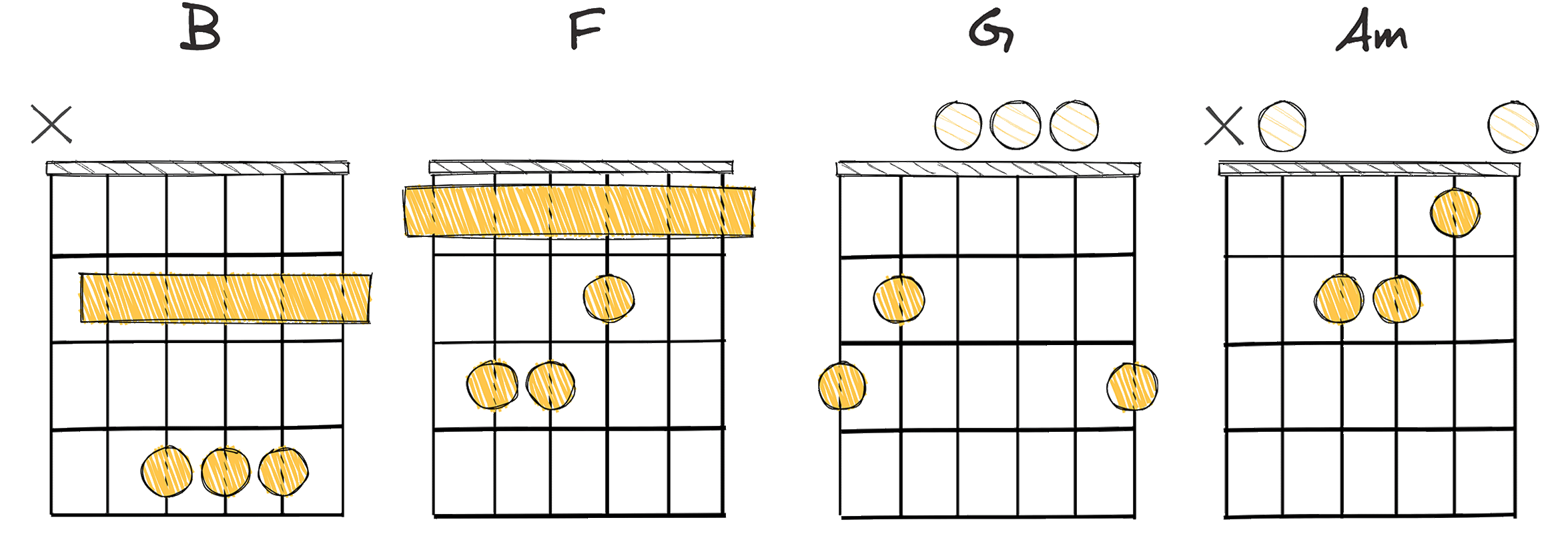
By examining the chord progression of II-VI-VII-i (2-6-7-1), which translates in the key of B – F – G – Am, we gain insight into some fundamental aspects of metal compositions.
Firstly, the progression starts with the B chord, a major chord built on the second degree of the A minor scale.
A major chord in this position can inject a sense of urgency and brightness, giving an energetic start to the progression – an essential quality in metal music.
Secondly, the progression moves to the F major chord, a major chord built on the sixth degree of the A minor scale, also known as the submediant.
Major chords on the sixth degree can create a somewhat reflective or poignant mood, a sensation often found in metal songs.
This transition to the F Major chord gives the progression its unique quality, balancing the initial brightness with a more reflective major chord.
Following the F Major, the progression advances to the G Major chord, the dominant chord in the key of A minor.
The dominant chord frequently precedes the tonic chord, leading to a resolution and a sense of conclusion in the melody.
In this II-VI-VII-i progression, the emphasis created by the dominant G Major chord is emphasized by its pivotal position before the final, resolving chord, thus enriching the melody’s overall tension and release dynamics.
The progression concludes with the A minor chord — this particular key’s tonic or ‘home’ chord.
The tonic chord’s primary role in a chord progression is establishing a tonal center, concluding the musical phrase, and offering a sense of resolution, thereby enabling the sequence to either finish or loop back to the beginning with graceful continuity.
This progression II-VI-VII-i (B – F – G – Am) provides a robust case study for comprehending the intricacies of crafting effective chord progressions in metal music.
The interchange between major and minor chords allows for a more profound emotional scope, leading to a potent and moving piece of music emblematic of the genre.
Thus, understanding the mechanics of chord progression, specifically the II-VI-VII-i sequence, can substantially assist emerging metal musicians in augmenting their compositional prowess.
i-III-VI-VII (1-3-6-7)
A haunting, ethereal progression that propels metal’s darker narratives.
The i-III-VI-VII chord progression creates a dark and mysterious atmosphere, characteristic of the metal genre. The leaps between chords inject a sense of dramatic tension and epic grandness, making it an effective progression for creating powerful, face-melting riffs and mind-blowing solos.
- Difficulty: Intermediate
- Example: Cm – Eb – Ab – Bb (Key of C minor)
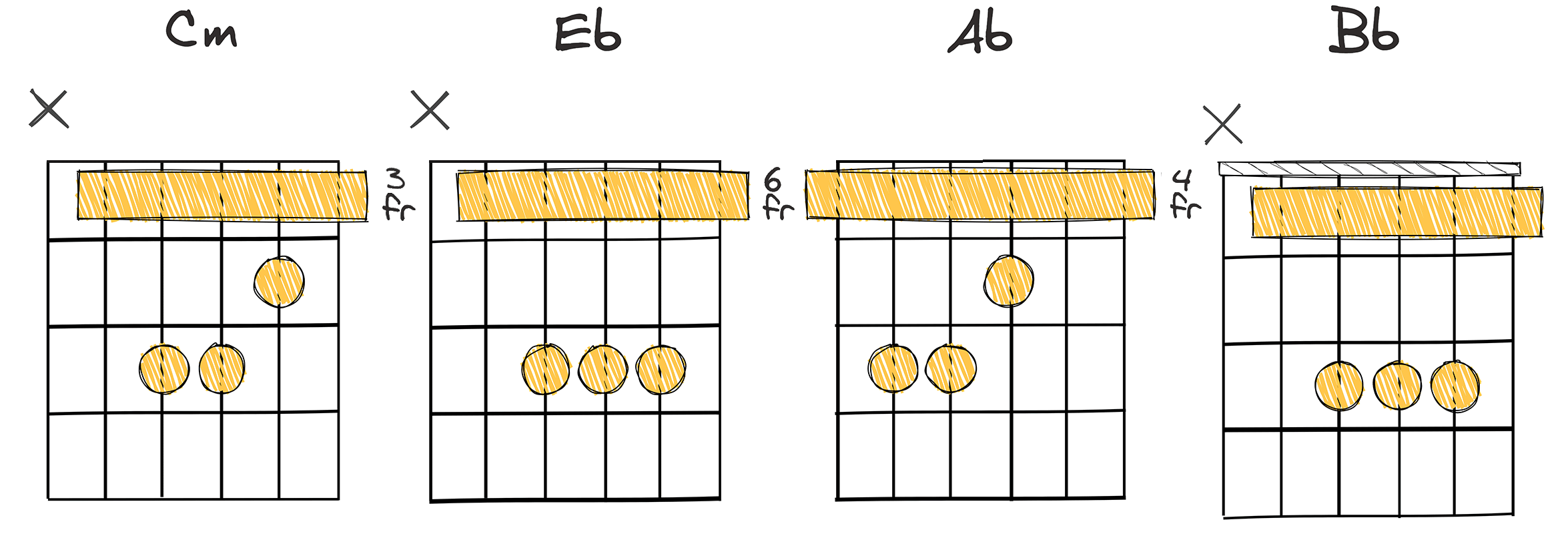
In the realm of metal music, chord progressions greatly impact the overall tone and feel of a piece.
Double escapement methods such as the i-III-VI-VII can be seen as complex, yet have the capacity to generate a distinct sound that has the potential to literally melt faces and blow minds!
Navigating the realms of these progressions can be challenging and requires an intermediate level of proficiency.
If you’re familiar with the music theory, you’d understand the numbered chords displayed here denote a sequence in a minor key.
Specifically, in this case, Cm – Eb – Ab – Bb all aligning with the key of C minor.
Delving further, this particular sequence i-III-VI-VII is intriguing and caters to the method of songwriting that encourages tension and release.
It is a creative approach that, when strategically implemented, can profoundly enhance the texture of metal music.
This progression employs a significant use of chords from the minor key.
The first chord, i (C Major in this example), adheres to the tonic, which serves as the anchor for the progression.
It’s like the home that the progression departs from and eventually returns to.
The next two chords, III (Eb) and VI (Ab), are inherently more ominous and beckon an unmistakable darkness that’s been a long standing hallmark in metal music.
Indeed, these chords, when played in succession, can entrain an intense rhythm.
The combination of the III (Eb) chord and the VI (Ab) chord introduces a level of tension that enhances the dramatic effect sought after in heavy genres of music.
Also, the choice to follow the VI (Ab) with the VII (Bb) chord creates an interesting dynamic.
The progression from the VI to the VII chord presents a distinct level of dissonance, another key characteristic in metal music.
It is worth noting that many influential metal bands adopted similar chord progressions to the i-III-VI-VII to create compelling musical narratives.
Therefore, understanding this unique chord progression and its theoretical underpinnings enables musicians to authentically contribute to the rich tapestry of metal music.
More than just a string of chords, the i-III-VI-VII progression represents a valuable tool for the generation of a distinctive atmosphere in metal music.
The effective use of this progression injects an instant layer of intensity, depth and range into a piece, thus underscoring the versatility of metal as a genre.
With the right level of understanding and accuracy, you too can deliver intense and mind-blowing music that employs such effective and passionate chord progressions, truly representing the spirit of metal music.
Engaging with this progression, whether as a musician or a passionate listener, offers an enjoyable, eye-opening journey into the expressive dynamics of metal music.
i-iv-VII-i (1-4-7-1)
A powerful, dark chord progression to invigorate metal compositions.
This formidable chord progression, i-iv-VII-i, is a cornerstone in the realm of heavy metal music, known for creating an intensely dramatic sound. It revolves primarily around the root, fourth, and seventh chords, amplifying the signature aggressive and powerful impression distinctive of the genre.
- Difficulty: Intermediate
- Example: Am – Dm – G – Am (Key of Am)
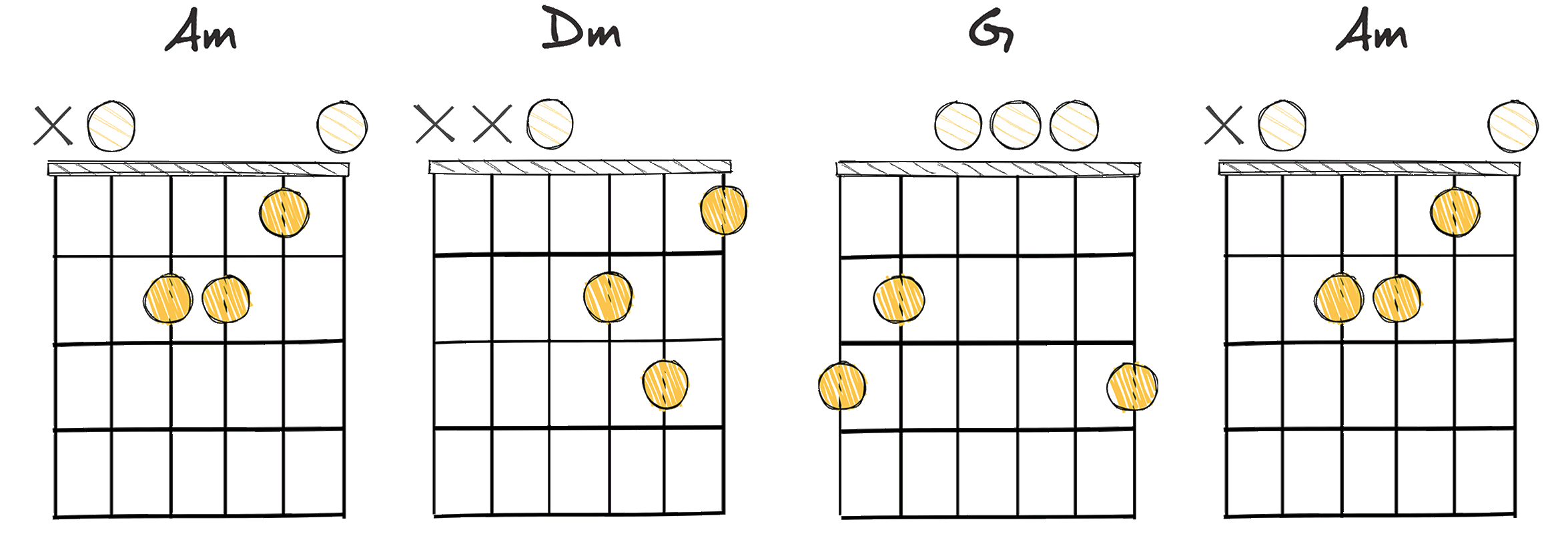
The chord progression i-iv-VII-i, in a metal context, typically explores the deeper, more haunting depths of musical emotion.
This progression, designated by the Roman numerals for 1-4-7-1, is also described with an equivalent chord structure as Am – Dm – G – Am in the key of Am.
Introduced in the darker sub-genres of the metal world, this progression creates an unearthly, eerie mood that matches the intense and raw emotions often depicted in this genre.
International metal acts, such as Black Sabbath or Metallica, have utilized such progressions to deliver intense emotion throughout their discography.
In essence, the progression delves into a musical narrative that is likely to resonate with hardcore aficionados of the genre, compelling them to empathize with the song’s emotional undercurrent.
The deep reach and rhythmical variance of this progression enable musicians to experiment with a variety of melodies, song structures, and lyrical themes.
In this progression, the ‘i’ or first chord often acts as an anchor, setting the mood for the progression while the iv and VII inject tension and offer a bit of relief, respectively.
Furthermore, the i returns at the end of the progression, providing a sweet homely sense of resolution after the tumultuous ride that its sister chords (IV and VII) offer.
The use of this particular – Am-Dm-G-Am chord progression – dates back to the early days of the metal era, when bands began infusing darker themes into their music.
While intermediate in terms of playability, this chord sequence demands precise execution and a strong theoretical understanding of the key it’s played in for optimal impact.
Its use across various sub-genres of metal, from thrash to doom, underscores the versatility and timeless resonance of the i-iv-VII-i progression.
Artists continue to use this progression in new and creative ways, pushing the boundaries of what can be achieved musically within the constraints of a set chord structure.
Moreover, the progression is thought to stimulate creativity and artistic exploration, prompting artists to delve into new lyrical territory and melodic invention.
Therefore, the i-iv-VII-i progressions plays a central role in the songwriting craft of many metal bands, acting as a vehicle for both cathartic expression and sonic innovation.
iii-IV-VII-I-II (3-4-7-1-2)
A tantalizing sequence fusing suspense and resolution in metal symphony.
The iii-IV-VII-I-II progression blends mystery with triumph. Beginning with an introspective F# minor, it evolves into hope with G major, adds excitement with an unexpected C# major, and then resolves contentedly to D major. Concluding with the energetic E major, this progression offers a compact yet emotive musical journey, suitable for genres like metal and progressive rock, adding depth and intrigue to any composition.
- Difficulty: Intermediate
- Example: F#m – G – C# – D – E (Key of D Major)

There is no denying that theiii-IV-VII-I-IIchord progression holds incredible value in the realm of heavy metal music.
Also known as the 3-4-7-1-2 progression in the numeral form, this series of harmonies ushers an outpour of raw and gripping emotions that can only be sufficiently appreciated when put into context.
Critical to understanding the nature and impact of this progression is acknowledging that it originates from the deep and resonant world of D Major.
This key is notably utilized in countless rock and metal songs due to its compatibility with the tuning of the electric guitar.
The natural harshness and depth, coupled with the distinct tuning of this key, allows for an effective projection of the bold sounds commonly associated with metal music.
Moreover, other chord progressions in this key such as the F#m – G – C# – D – E, are also frequently used, further underpinning its significance in the genre.
Now, let’s take a closer look at the first chord of the iii-IV-VII-I-II progression- the iii or F# minor.
In the arena of metal music, this chord commands attention with its combination of a melancholic tone and a powerful dominant quality.
Moving on to the IV or G major chord, this shifts the mood slightly towards a more positive and uplifting feeling, a clever contrast to its predecessor.
The VII or C# chord furthers this narrative, adding a touch of somberness and gravity to the unraveling melody.
Following the C# is the all-important i or D major chord.
This is the chord to which all preceding ones lead to, and hence, it produces a sense of resolution and completeness.
Finally, the progression concludes with the II or E major chord which brings us back full circle to a darker, more melancholic ambiance while beaming with intense emotions.
In the key of D major, replacing the E minor (Em) chord with an E major creates a chromatic alteration, introducing a G# note which isn’t naturally found in the D major scale.
The E major chord in this context is often referred to as a secondary dominant (specifically V/V, or the dominant of the dominant).
With such intricate detailing in its composition and the emotions it conveys, it’s no surprise that numerous bands have utilized this progression.
i-iv-VI-i (1-4-6-1)
A brooding progression serving up haunting harmonies and intense vibes.
This i-iv-VI-i (1-4-6-1) progression is a dark and powerful combination of chords frequently used in metal to create a stormy, intense atmosphere. The shift from the minor root to the major fourth and sixth can evoke an eerie, disquieting tone before returning to the root for a satisfying resolution, perfect for a potent, mind-blowing climax.
- Difficulty: Intermediate
- Example: Dm – Gm – Bb – Dm (Key of D minor)
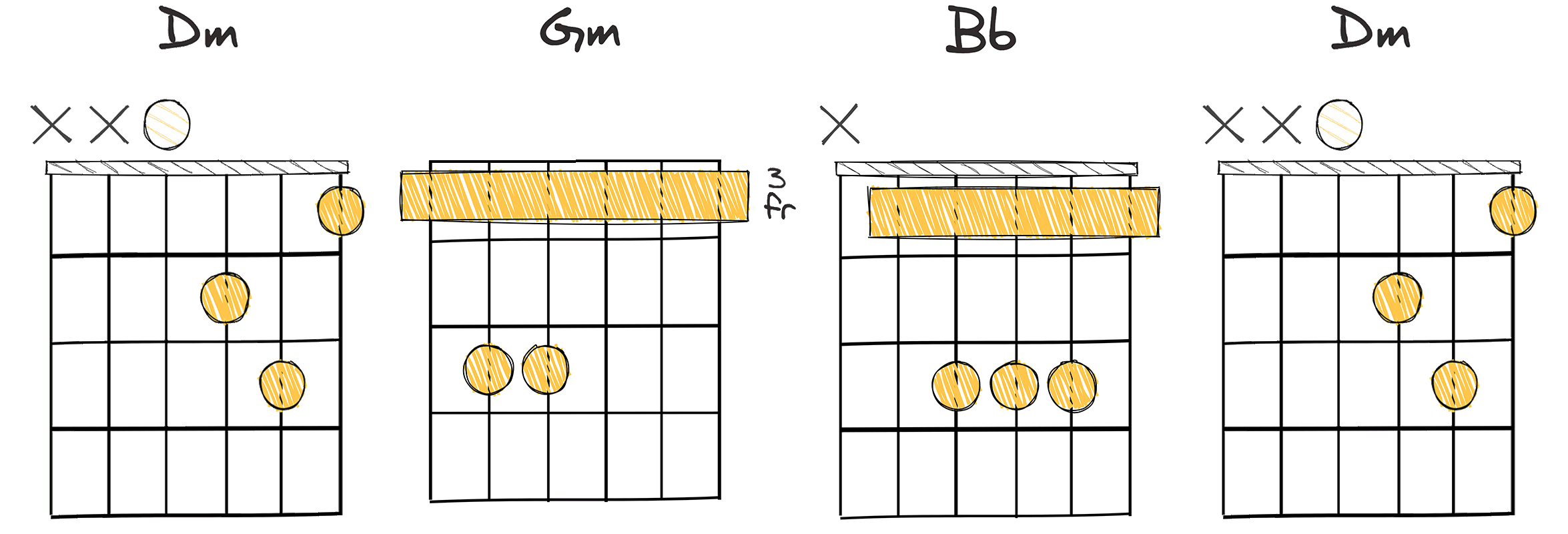
The 12th chord progression in the outline is the i-iv-VI-i, also known as Dm – Gm – Bb – Dm in the key of D minor.
This chord progression holds a distinctive place in the realm of metal music and has been a staple in the arsenals of many influential metal bands throughout history.
A distinctive feature of this progression is its inherent dramatic tension, primarily resulting from the transition between the minor i chord to the major IV.
The specific sequence of chords injects the feeling of urgency and unease that metal music is typically associated with.
Indeed, the i-iv-VI-i chord progression can be seen as an embodiment of the raw, chaotic, and emotional expressiveness characterized by heavier metal subgenres.
This quoted statement reflects the immense contribution of this progression in manifesting the quintessential metallic sound.
The shift of chords from minor to major evokes a sense of unpredictability, an element that is a cornerstone in establishing the suspenseful atmosphere prevalent in metal music.
Moreover, the progression’s peculiar transition from the VI chord back to the minor i chord, as exemplified in the Dm – Gm – Bb – Dm progression, adds a layer of somberness, reinforcing the gloomy and intense mood often favored by many metal musicians.
In terms of its role in musical history, the i-iv-VI-i has been an intermediate chord progression used in numerous iconic metal songs.
Its usage goes beyond simple compositional convenience; it has been instrumental in shaping the genre’s overall musical landscape.
Furthermore, the i-iv-VI-i’s influence is not confined to one particular subgenre of metal; it sees expression in thrash, death, black, and even progressive metal.
The chord progression’s versatility and malleability stand as a testament to its significance in the metal scene.
Although being of an intermediate level in complexity, the i-iv-VI-i requires a guitarist to have a firm grasp on shifting chord shapes along different fret positions, and hence, it can be considered as a gateway progression to more complex musical arrangements within the metal genre.
On a closing note, while the i-iv-VI-i’s usage and thematic resonance within the metal genre are significant, this progression’s depth transcends boundaries and finds inherent value in a variety of other musical genres, testifying to its universal allure.
I-iii-IV-vi (1-3-4-6)
A harmonious rampage of power and emotion in four chords.
This chord progression, often found in the genre of heavy metal music, creates a ascending harmonic sequence that also builds tension. The I-iii-IV-vi progression is distinctive, featuring major key shifts and emotion-driven impact, making it the ideal choice for compositions aiming to create intense, mind-blowing musical experiences.
- Difficulty: Intermediate
- Example: C – Em – F – Am (Key of C)
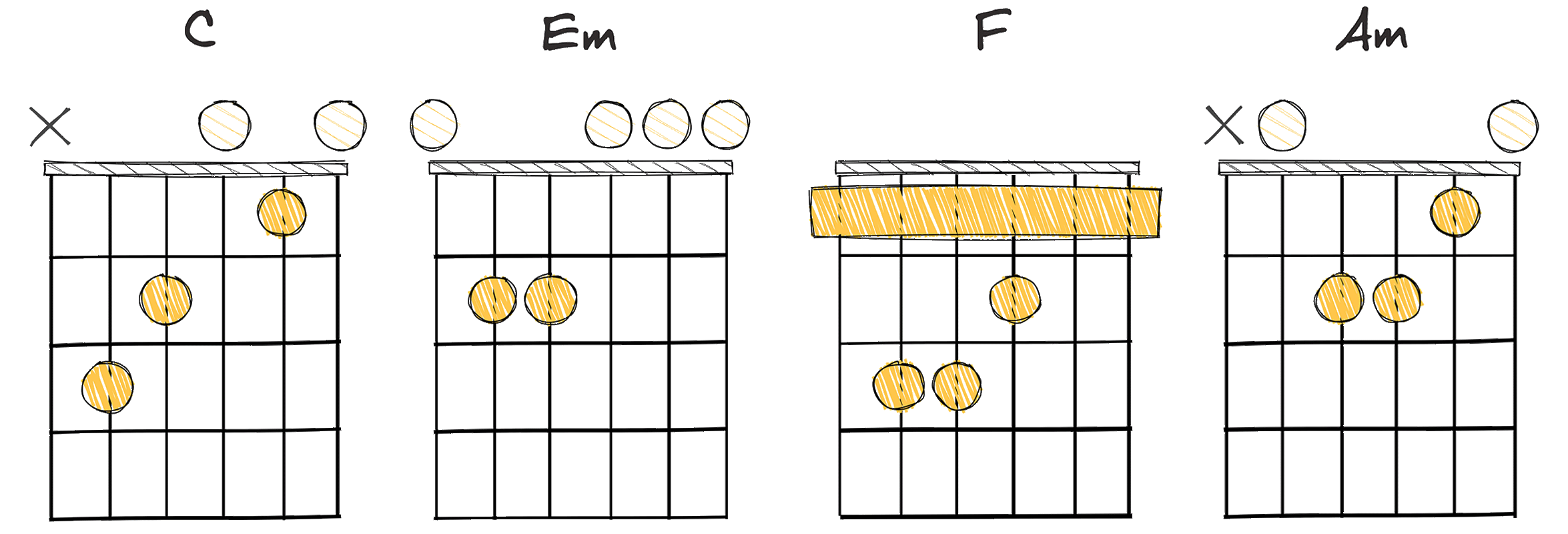
The I-iii-IV-vi progression, or in common terms, C Major – E Minor – F Major – A Minor in the key of C, is a powerful chord progression used in many iconic metal tracks.
Given its vast use in the genre, this progression holds a unique place in the history of metal music.
What makes this progression particularly exciting for metal players is its intermediate level of difficulty, striking the right balance between achievable playability and technical complexity.
Navigating the transition from E Minor to F Major, for instance, presents a bit of a challenge that pushes many guitarists to heighten their skills.
Recent studies have confirmed that this specific chord progression helps guitar players enhance their technical know-how.
It does not only teach them precision but also introduces them to the world of melancholic and dramatic tones.
These tones are significant contributors to the distinctive sound of metal music.
Interestingly, the origin of this chord progression can be traced back to more classic rock songs than one could guess.
It went on to find its place in metal as the genre evolved, and musicians melded influences from its rock roots with their developing metallic sound.
As the genre of metal continued to evolve, the I-iii-IV-vi progression became a staple among many artists, solidifying its significant role in the realm of this music.
The I-iii-IV-vi progression’s dominance, however, should not make you believe that metal is confined within these chords.
Indeed, while its importance cannot be overlooked, the diverse landscape of metal music continues to incorporate a wide range of other progressions and techniques.
Remember, the exploration of these chord progressions is all part of lifting the veil behind metal’s massive sound and understanding why it has such a powerful impact on us.
i-II-iv-VI (1-2-4-6)
Unleashing a haunting resonance, perfect for creating an intense metal atmosphere.
This i-II-iv-VI progression is characterized by its dramatic and intense shifting that creates a powerful metal sound. The progression’s unconventional turn from minor to major chords commands a sense of mystery, which is perfect for producing an exhilarating, darker tone common in heavy metal music.
- Difficulty: Intermediate
- Example: Cm – D – Fm – A (Key of C minor)
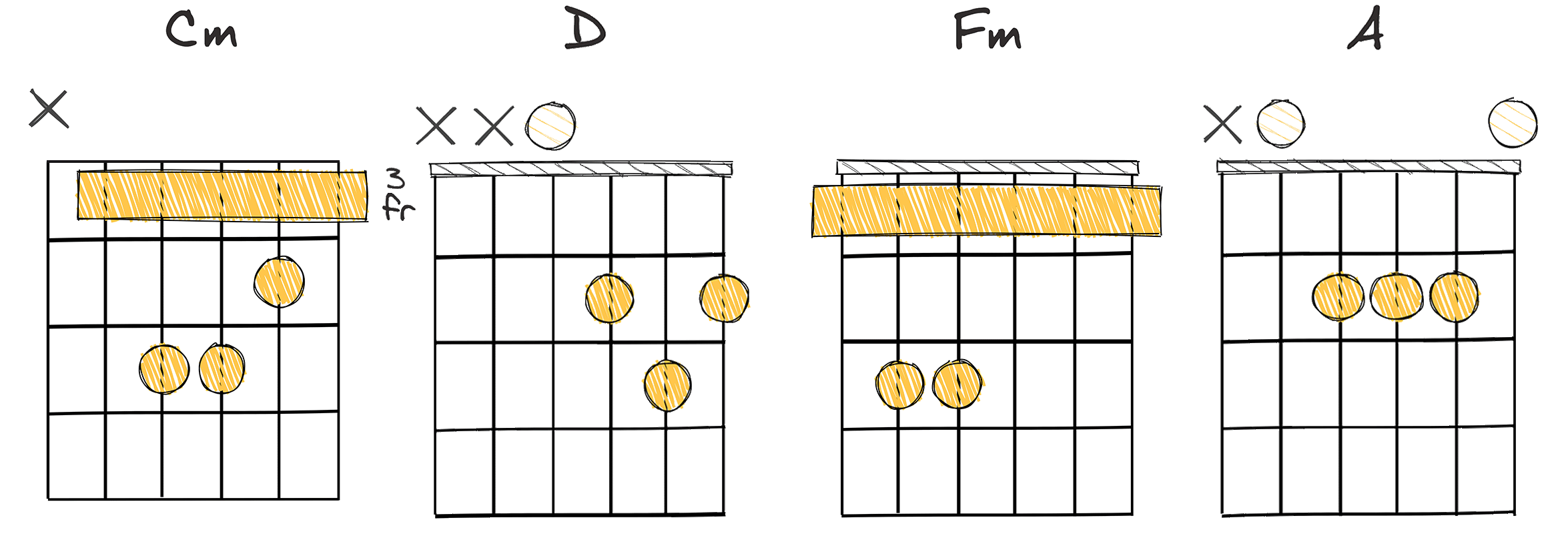
The i-II-iv-VI is a powerful progression in the realm of Metal music that has been used in countless songs, resonating with the potent energy this genre holds.
This chord progression, typically associated with the Key of C minor, reflects the order: Cm – D – Fm – A.
Given its intermediacy, it allows musicians an avenue to explore more complex variations, whilst still maintaining a strong backbone for their composition.
Because of this neat alignment of features, the chord progression offers both familiarity and surprise, making it a staple in many compositions.
Its historical prevalence in metal music offers proof of its effectiveness.
Great bands like Metallica, Iron Maiden, and Judas Priest have all utilized this progression in their infamously ground-breaking tracks.
The exact origins of this particular progression can be traced back to the classical era, but it wasn’t until the emergence of the metal genre that it truly came into the limelight.
The raw and powerful emotions that metal music expresses are often mirrored in the chords used in its composition, and the i-II-iv-VI chord progression is no exception.
The chord’s contrast between minor and major tones reflects the genre’s signature tension and release dynamic.
The i chord establishes a dark and brooding presence – the quintessence of metal music.
Followed subsequently by II that injects a stark contrast into the pattern, setting the stage for an emotional climax built by iv.
Finally, the progression concludes with VI — the emotional resolution, leaving an echoing resounding resonance.
This sequence of chords amplifies the emotional weight of metal music, intensifying the overall dramatic effect.
It’s worth noting that, eve though this progression has been prevalent in the genre for decades, it still retains its original charm.
In addition, the flexibility of the i-II-iv-VI progression allows musicians to experiment and create their unique spin on this classic format while keeping the original emotionality intact.
In this ever-evolving journey of metal music, the i-II-iv-VI progression stands firm as a timeless classic, inspiring musicians to venture out into the unknown, to melt faces and blow minds!
iii-vi-VII-II-vi (3-6-7-2-6)
Unleashing intense power through unexpected shifts and potent dissonance.
This chord progression features a dramatic sequence that moves from the third to the sixth, seventh, second and back to the sixth, producing a dynamic and powerful sound. It’s a frequent choice for metal music because of its ability to create emotionally charged and tension-filled moments, often resulting in an exhilarating sonic experience for listeners.
- Difficulty: Intermediate
- Example: Bm – Em – F# – A – Em (Key of G)

One of the more intense chord progressions you may find in metal music, which can certainly melt faces and blow minds, is the iii-vi-VII-II-vi progression.
This progression, often implemented in an Intermediate level of play, can add a sophisticated and gripping depth to your music.
Bm – Em – F# – Am – Em is one example of this progression in the Key of G.
It’s a style often utilized in genres involving sheer intensity, such as speed metal, thrash metal, and progressive metal.
While this progression may present some challenges, the reward is a surefire way to impress listeners with your music’s surprising complexity.
The combination of chords provides a deep, powerful sound that truly captures the spirit of the genre.
A key benefit of the iii-vi-VII-II-vi progression is its ability to maintain audience interest due to its unpredictability and variation.
From a historical perspective, this progression has been staple for many artists in the metal genre exploring their own signature sounds.
It’s an example of the creative innovation that has driven metal music forward throughout the decades.
While embodying aggression and intensity, it also introduces melodic surprise, adding contrast to the overall piece.
Expand your metal prowess by trying out this memorable progression and see how it blends with your personal style.
With more exploration and experimentation, the iii-vi-VII-II-vi progression may become a fundamental part of your heavy metal repertoire.
i-VI-III-VII (1-6-3-7)
A menacing progression for intense, evocative mind-bending metal mayhem.
This i-VI-III-VII progression is a staple in heavy metal, driving the intensity and emotional depth of the genre. The transition from the first chord to the diminished sixth, then to the mediant and finally to the subtonic creates a dark, dramatic sound, epitomizing the powerful impact of metal music.
- Difficulty: Intermediate
- Example: Dm – Bb – F – C (Key of D Minor)
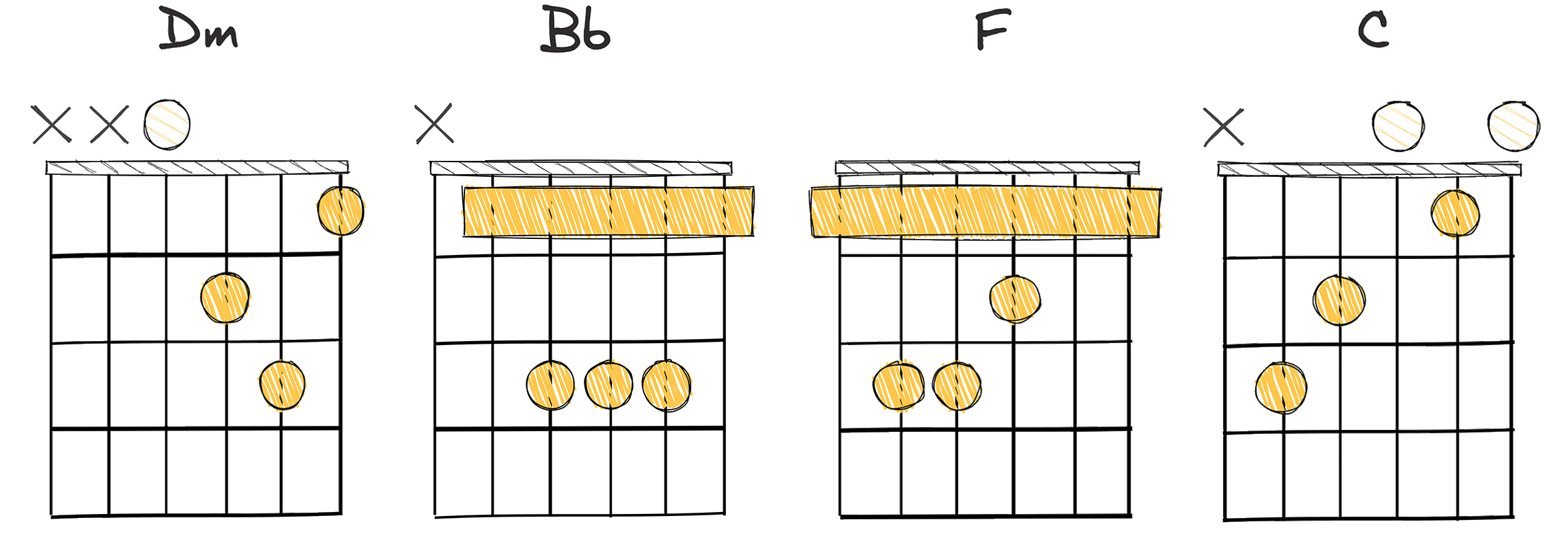
The chord progression i-VI-III-VII (1-6-3-7) is no stranger to the thrilling world of metal music.
Known for its powerful resonances as well as its distinctive ominous tone, it’s been a common go-to for many metal musicians over the years.
With roots nested deeply in the classical tradition, it’s interesting to note how this progression has made its way into the modern, contemporary metal scene.
Evoking a dark, haunting sound reminiscent of past eras, this chord progression certainly holds its own in the landscape of heavy guitar and thunderous drums.
Intermediate players find this sequence challenging yet rewarding.
It’s a chord progression that requires a keen understanding of musical theory and precise execution, but the payoff is incredible: a haunting and memorable sound that leaves a lasting impression.
This challenging nature is part of its allure, pushing musicians to hone their craft and mature their technical prowess.
This chord progression definitely makes the metal genre sound the way it does — incredibly impactful with an almost palpable energy.
Indeed, in the right hands, it can be manipulated to cultivate emotional resonance, keeping audiences on the edge of their seats.
In effect, the i-VI-III-VII (1-6-3-7) chord progression is far from being just a melodic sequence to follow; it is a critical tool that can shape the mood and atmosphere of any piece.
Worth noting is that any metal musician looking to take their music to the next level would do well to master this dynamic chord progression.
Despite its intimidating persona, one shouldn’t be discouraged; grasping this progression can open up a whole new vista of musical possibilities.
ii-vi-ii-III-vi (2-6-2-3-6)
An audacious progression fusing bold intensity with unexpected melodic twists.
This particular chord progression, ii-vi-ii-III-vi (2-6-2-3-6), creates a heavy and compelling sound that is often associated with the raw intensity of metal music. The progression’s melodic tension and resolution produce dramatic effects, making it a powerful tool for musicians aiming to create emotional depth in their performances.
- Difficulty: Intermediate
- Example: Dm – Am – Dm – E – Am (Key of C)

Crushing progressive sequences resonate deeply with metal fans and musicians alike, deeming chord progression Iii-vi-ii-III-vi (2-6-2-3-6) an integral part of the metal panorama.
Chord progression ii-vi-ii-III-vi, also known as 2-6-2-3-6 corresponds to an intermediate level of guitar playing, which offers a unique blend of tones and emotions that are distinctive in the metal genre.
This chord progression genuinely showcases the expressive versatility and emotional depth of the metal genre.
Referenced in the chord progression is the intricate layering of IInd, VIth, IInd, IIIrd, and VIth chords, respectively.
The continuous use of these chords, albeit seemingly complex, offers a distinct sound and harmonic structure that can be fascinating to the metal audience.
The chords commonly manifest themselves on a Dm – Am – Dm – E – Am pattern within the key of C.
This specific pattern has been used in countless legendary metal songs to create a more diversified and dramatic musical experience.
This chord progression has slowly evolved over time, being particularly influenced by the creative exploration of the 1970s and 1980s heavy metal bands
Upon examining the discourse of metal music, it becomes evident that chord progression ii-vi-ii-III-vi plays a vital role in conveying the powerful and intense emotional states that are central to the genre.
For those who seek to master the complexity of metal. implementing this chord progression into their music can serve as a step on their path to success.
Considered an intermediate difficulty, this specific chord progression necessitates a good handle on guitar techniques and a solid understanding of chord structures, positioning, and transitions.
Embraced by guitarists hoping to harness its potential, the chord progression ii-vi-ii-III-vi offers a wealth of possibilities for dynamic musical expression with a signature metal vibe.
Such chord progressions are prime examples of the genre’s broad musical range, offering a glimpse into the complex musical architectures that underlie the surface of metal tracks.
The Bottom Line
After thoroughly examining and analyzing the distinct patterns detailed above, it is evident that each sequence forms unique combinations which can be utilized in various areas such as music creation, coding systems, or solving mathematical problems, among other applications.
The flexibility and diverse range of combinations reflect the broad applicability these sequences may possess.
This study underscores the cardinal role of permutations in numerous fields, bringing to light the profound connections and impacts these numerical sequences hold within our daily lives.
Ultimately, this highlights the significance of such distinctive patterns and their expansive potential in fostering innovative solutions and breakthroughs.
In love with guitars, and gear; expert in all things music! Been writing about guitars for about 5 years and counting. Born in the ’90s. Alma Mater: University of Havana. Always curious, trying to understand the world. #TeamFender




